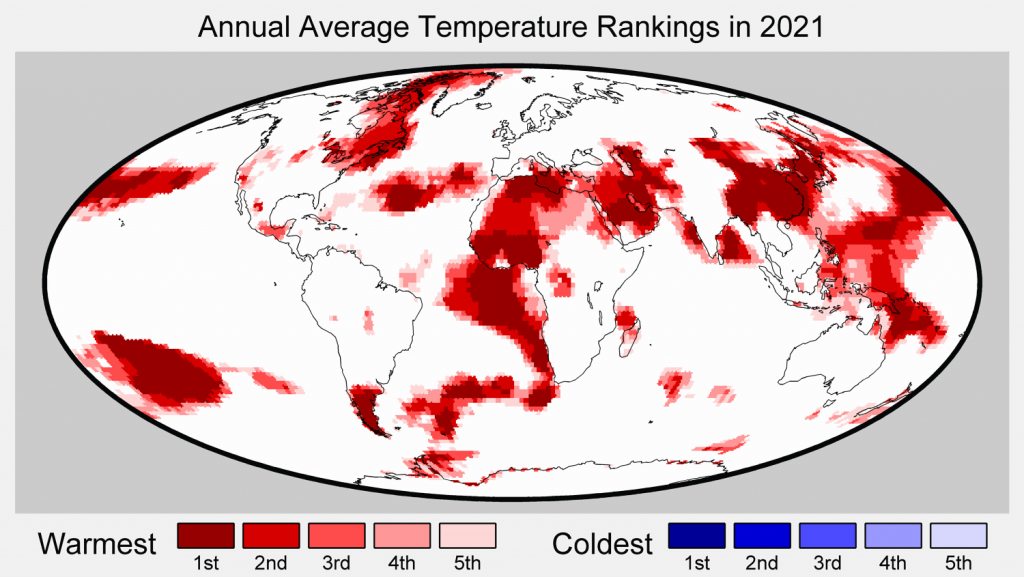BERKELEY, CA — Berkeley Earth today released its annual report on global mean temperature, concluding that while 2021 was significantly colder than 2020, it was nominally the sixth warmest year on Earth since 1850, 1.2 degrees Celsius (2.2F) above the 1850 to 1900 average.
Given the uncertainties associated with temperature measurements, the years 2015, 2018, and 2021 are essentially tied as the fifth, sixth, and seventh warmest years.
While the global average temperature did not set a new record in 2021, China, Nigeria and 23 other countries experienced their warmest year on record in 2021. Approximately 1.8 billion people worldwide experienced a record-warm annual average in 2021.
”No one lives at the global average temperature,” said Berkeley Earth Lead Scientist Dr. Robert Rohde. “Most land areas will experience more warming than the global average, and countries must plan their responses to this.”
Year-to-year rankings are likely to reflect short-term natural variability. In 2021, a persistent La Niña event was likely responsible for reduced temperatures when compared to years without a La Niña event. Overall, the long-term trend remains consistent with an ongoing pattern of global warming.
In summary, 2021 was notable for:
- New record high annual averages in 25 countries, including China, South Korea, and Nigeria;
- A relatively cool year in the Arctic Ocean;
- Extreme events, including an extraordinary heatwave on the West Coast of North America.
On land, 2021 was nominally the fifth warmest year observed, and effectively tied with 2015. This is significantly cooler than 2020, which was the warmest year on land.
Local Temperature Distribution and Ocean Temps in 2021
As can be expected from the global warming caused by greenhouse gases, the temperature increase over the globe is broadly distributed, affecting nearly all land and ocean areas. In 2021, 87 percent of the Earth’s surface was significantly warmer than the average temperature during 1951-1980, 11 percent was of a similar temperature, and only 2.6 percent was significantly colder.
“We estimate that 8.3 percent of the Earth’s surface set a new local record for the warmest annual average,” Rohde said. “In 2021, no place on Earth experienced a record cold annual average.”
Land areas generally show more than twice as much warming as the ocean. When compared to the 1850-1900 averages, the land average in 2021 has increased 1.70 ± 0.04 degrees Celsius (3.06 ± 0.08 F), and the ocean surface temperature, excluding sea ice regions, has increased 0.83 ± 0.05 degrees Celsius (1.49 ± 0.08 F).
As in other recent years, 2021 shows strong warming over the Arctic that exceeds the Earth’s mean rate of warming. This is consistent with the process known as Arctic amplification. By melting sea ice and decreasing snow cover, warming in the Arctic regions causes more sunlight to be absorbed, which allows for yet more warming. However, 2021 was not as warm as other recent years, and ranked only 13th overall. Similarly, sea ice melt in 2021 was less extreme than other recent years, though still well ahead of what was typical 30 years ago.
2021 Brings Warmest Annual Averages to 1.8 Billion People
Berkeley Earth data can be used to estimate local temperature trends. In 2021 locations home to about 1.8 billion people saw record high annual averages. The largest contributor to this was record warmth over much of China.
The national averages for these 25 countries were the warmest since instrumental records began: Bangladesh, Bahrain, Benin, Bhutan, Burkina Faso, China, Ghana, Guinea, Iran, Kuwait, Liberia, Malta, Myanmar, Nigeria, North Korea, Oman, Qatar, Saudi Arabia, Senegal, Sierra Leone, South Korea, Togo, Tunisia, Turkmenistan, United Arab Emirates.
Due to uncertainties in the analysis and the limits of our spatial resolution some national average estimates may differ slightly from the values reported by national weather agencies.

Prediction for 2022 and beyond
Based on current conditions, we expect that 2022 temperatures will be similar to or slightly warmer than 2021. Due to the return of La Niña conditions at the end of 2021, it is unlikely that 2022 will be a record warm year.
The Paris Agreement on Climate Change aims to keep global temperature rise to well below 2 degrees Celsius (3.6 F) and encourages parties to strive for warming of no more than 1.5 degrees Celsius (2.7 F). At the current rate of progression, the increase in Earth’s long-term average temperature will reach 1.5 degrees Celsius (2.7 F) above the 1850-1900 average by about 2033 and 2 degrees Celsius (3.6 F) will be reached in about 2059.
As a resource for policymakers, in 2021 Berkeley Earth published the world’s first and only country-level warming projections based on current emissions scenarios; those can be found here.
“The increasing abundance of greenhouse gases in the atmosphere due to human activities is the direct cause of recent global warming,” Rohde said. “If the Paris Agreement’s goal of no more than 2 degrees Celsius (3.6 F) warming is to be reached, significant progress toward reducing greenhouse gas emissions needs to be made soon.”
Further Information
The full report can be found here.
About Berkeley Earth
Open-source from the outset, Berkeley Earth’s data sets are differentiated by a more flexible, inclusive approach for analyzing temperature observations, allowing us to incorporate data from a greater number of the world’s temperature stations. Created around our values of independence, impartiality, scientific excellence, and open-source science, our unique handling of interpolation and systematic biases helps to ensure the most detailed picture of climate change. Trusted by the UN IPCC in its 2018 and 2019 Special Reports on Global Warming, and cited in more than 1,800 scholarly and academic papers, our surface temperature data sets are foundational to research, policy, and education. We continue to update our data sets monthly, ensuring open-source access to the highest-quality global temperature data.

